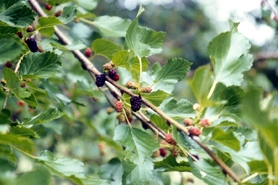White mulberry
(Morus alba)
A deciduous tree or shrub reaches 30-50 feet tall. Plants have variable leaf shapes from simple to deeply lobed, with edible fruits ranging from white to red to black as they ripen.
Other names for this plant include:
- Common names: Chinese white mulberry, common mulberry, Russian mulberry, silkworm mulberry, chi sang, chin sang, moral blanco
- Scientific names: M. alba var. constantinopolitana, Morus alba var. multicaulis, Morus tatarica, Morus indica, Morus multicaulis
Classification in Wisconsin: Restricted (male cultivars exempt)
- Ecological Threat
-
- Invades open forests, woodland edges, prairies, fields, and disturbed areas.
- Tolerant of various conditions; salt-tolerant, withstands drought and wind-resistant.
- Outcompetes and hybridizes with our native mulberry, replacing those populations.
- Identification
-
Leaves & stems: Alternate, glossy green leaves vary significantly in shape from simple to lobed on the same tree. Often younger trees and trees found in full sun have more extraordinary lobed leaves. Trees found in the shade tend to have more simple leaves. Leaves have three strong veins originating from the base. Leaves turn pale yellow in the fall. The bark of young trees is brownish-orange with lenticels. As plants age, the bark turns gray and develops irregular cracks or ridges.
Flowers: Flowers are perfect, containing both female and male reproductive organs. Flowers are small, greenish to yellow and occur in spikes.
Fruits & seeds: Fruits resemble other mulberry species or slender blackberries. Fruits change from white to red to black as they ripen. Fruits are edible.
Similar species: White mulberry resembles American or red mulberry (Morus rubra; native). This native mulberry species tends to be more of a shrub and the leaves are simple.
For more identification information, visit the Wisconsin State Herbarium link under the resources tab.
- Control
- Mechanical:
- Hand pull, dig or use a weed wrench to remove younger trees.
- Girdle more giant trees or cut and grind the stump.
- Cut trees and immediately paint the stumps with glyphosate.
- Resources
- Sources for content:
- Carey, Jennifer H. 1994. Artemisia absinthium. In: Fire Effects Information System, [Online]. U.S. Department of Agriculture, Forest Service, Rocky Mountain Research Station, Fire Sciences Laboratory (Producer).[2013, August 12].
- University of Wisconsin - Stevens Point, Robert W. Freckmann Herbarium
- Center for Invasive Species and Ecosystem Management; invasive.org



